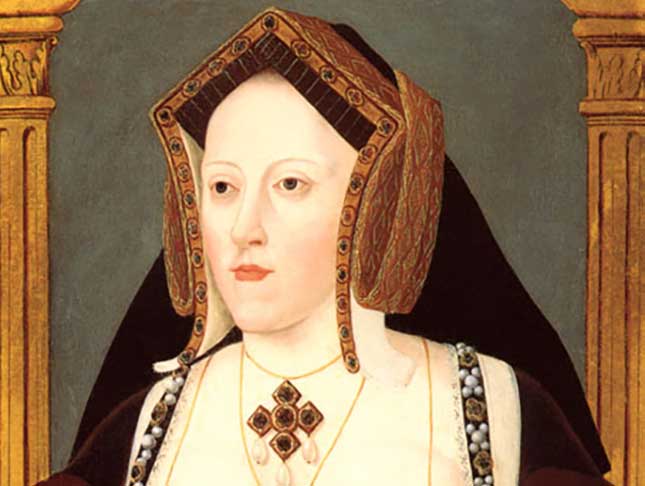Melita Thomas explores King Henry VIII’s first love, Katharine of Aragon
Katharine is one of the best known queens of England – first wife of King Henry VIII and mother of England’s first queen regnant, Mary I. The story of Katharine’s life often concentrates on her bitter fight to prevent Henry divorcing her and her final years when she was banished to a series of isolated castles, sending futile letters to the Pope and the Emperor, begging for justice, while Henry caroused with his new wife.
But there is more to Katharine’s story than that. She was the daughter of two monarchs, Ferdinand and Isabella, whose marriage transformed mediaeval Spain into a powerhouse – bastion of the Catholic Church, and conqueror of the New World. Katharine was destined from childhood to make a diplomatic marriage to support her parents’ ambitions.
In 1501, aged 15, Katharine sailed for England to marry Arthur, Prince of Wales, heir to the English throne. Within five months, he had died, leaving the princess alone in a foreign land. To preserve the alliance, Katharine was betrothed to her brother-in-law, Henry. The necessary papal dispensation was obtained and the widow settled down to wait for Henry to reach marriageable age. Katharine’s existence during this period was miserable. Neither married nor free, she was in limbo, in poor health and short of money, as arguments over her dowry escalated between her money-grubbing father-in-law, Henry VII, and her double-dealing father.
Life improved in 1507 when Katharine was formally accredited as her father’s ambassador. While the role of women in diplomacy through marriage was familiar, this is the first instance of a woman being given an official position. Katharine took to it with gusto, writing in code and negotiating her marriage treaty.
In 1509, Henry VII died, and, within weeks, young Henry claimed his bride. This was the beginning of Katharine’s glory days. Crowned together on Midsummer Day, she and Henry were deeply in love and shared everything. Foreign ambassadors reported her influence over him and their joint ambition (entirely unrealistic) to regain the crown of France.
Katharine’s political sway peaked in 1513 when she was declared Regent as Henry crossed the Channel to make good his boasts. In Henry’s absence, James IV of Scotland invaded England. Katharine, emulating her warrior mother, raised an army and set out to join the force led by the Earl of Surrey. The victory at Flodden, achieved before Katharine had got further than Buckinghamshire, was the most notable military achievement of Henry’s reign. In bloodthirsty triumph, Katharine contemplated sending James IV’s body to France as a trophy.
Meanwhile, Ferdinand had let Henry down by making peace with France and this was to rebound on Katharine. English policy moved towards rapprochement with the old enemy, and her influence was superseded by that of Cardinal Wolsey.
Politics would not have mattered had Katharine given birth to a son, but, from 1510, she suffered a series of miscarriages, and still births. Only in 1516 would the couple have a baby who survived. Unfortunately for Henry’s dynastic ambitions, it was a daughter, Mary. A final pregnancy in 1518 also ended in tragedy.
In 1524 the Queen’s life was calm. After the flirtation with France, Henry had renewed the Spanish alliance with Katharine’s nephew, the Emperor Charles V. Charles had agreed to marry their daughter, and Henry could look forward to having a grandson who was not only king of England but emperor as well.
A year later, everything fell apart. Charles broke off the betrothal and at the same time, Henry fell violently in love with Anne Boleyn, who was not prepared to be his mistress.
With no son, a failed alliance and dreams of a new wife, Henry sought to have their marriage annulled, basing his argument on the biblical text that a man should not have relations with his brother’s wife. The theological arguments were complex and debate raged for years. Katharine maintained throughout that her marriage with Arthur had never been consummated so no impediment to marriage with Henry existed.
Katharine was supported in words, if not in deeds, by Emperor Charles so the Pope, Clement VII vacillated, unwilling to make a decision for fear of offending either party. The court convened to hear the case ended in a shambles when Katharine made a dramatic speech defending her position, before walking out, protesting that the judges were biased.
By 1531, increasing frustration led Henry to separate Katharine from Mary and banish her from court. Two years later, his patience had run out completely: he and Anne married in secret and the Archbishop of Canterbury, Cranmer, declared Katharine’s marriage invalid. In 1534, the Act of Succession made it a crime to call Katharine queen, and named Anne’s daughter as Henry’s heir.
Katharine refused to accept this – maintaining that she was queen, and Mary the legitimate heir. She continued to urge the Pope to make a ruling in her favour, but it was too late. His authority was no longer recognised in England and, although Charles continued to complain about his aunt’s treatment, he took no concrete steps to preserve her position.
In 1536 Katharine died, just 51 years old. Her memory lives on – the spirit of a woman who would not bow to pressure, but maintained her truth to the end – a faithful and loving wife, a devoted mother and a queen much loved by the people.
77






 © 2024
© 2024